Driving from T or C to our next destination in Alamogordo was a challenge, because a weather front brought us 20 mph winds that whipped up the fine New Mexico sands into fog-like sandstorms. Despite the inauspicious start to our stay, we ended up really enjoying Alamogordo. We took our cues directly from our friends at Chapter 3 Travels (post here) and Chasing Dirt (post here) which made it easy to figure out how best to spend our week.
Oliver Lee Memorial State Park
Our camping site for the week was in Oliver Lee Memorial State Park, where we had a reserved site with water and electric hookups for the pleasantly low price of $14/night. Even more surprising was how scenic the park was. Despite being on the inside of the loop, and in a desert environment with no trees, our site was elevated on a bluff and we had eye-popping views from our rear panoramic windows. Sunsets over the Tularosa Valley were truly spectacular. The bathhouse was also one of the nicer ones we have seen in New Mexico, where state parks have either lacked shower facilities altogether or offered facilities that were spartan, to put it kindly.
There are multiple opportunities to hike right from the campground, and we explored several. The Dog Canyon Trail is the most challenging, and we only tackled the first 3 miles or so before turning around. This was a tough hike thanks to the steep incline on the way up the canyon and loose rocks making for treacherous footing on the way down. Fortunately the outstanding views over the valley gave us plenty of reasons to stop for photo breaks and plenty of rewards for our effort.
The state park is located on the former ranch of a fellow named Oliver Lee, and one day I participated in a docent-led tour of Lee’s ranch home. The house is a reconstruction based on extensive archeological surveys, and is also fairly typical for late 19th century / early 20th century frontier structures. After all the historic places we have visited, I was not exactly amazed to see furnishings like a cast iron stove, a foot-cranked sewing machine, and chamber pots in the bedrooms. But the volunteer docent did an excellent job regaling the group with tales of the wild west featuring range wars, shady characters, and legendary lawmen. He also deftly explained the geology and hydrology of the Tularosa Basin and its transition from a verdant grassland to its current desert condition thanks to overgrazing.
Between the excellent views, the hiking opportunities, and the creature comforts, this park was a winner for us.
New Mexico Museum of Space History
We are certified space junkies as well as holders of a science museum membership that provides free entry to hundreds of science museums around the country; our membership happens to be with the Lowell Observatory. This meant that we were sure to include a visit to the New Mexico Museum of Space History on our itinerary for Alamogordo, and a chilly day provided us the perfect excuse to stay warm by visiting the mostly indoor museum. A significant amount of the research that led to space travel took place in the vicinity of Alamogordo, at the White Sands Missile Range and the Holloman Air Force Base, and as a result the museum has an extensive collection of unique items.
White Sands is the place the US military has been shooting off experimental missiles for over 70 years, from V-2 rockets captured in Germany after World War II to multistage rockets used for ICBMs to experimental components of the 1980s-era “Star Wars” Strategic Defense Initiative. The space history museum has decommissioned rockets from all these eras along with interesting descriptions of their motors. As an aside, we are about 100 miles from Roswell, NM, the epicenter of UFO theories. I have no doubt that the cutting-edge machinery being launched at White Sands and Holloman has contributed to the “sightings” in Roswell — we’ve been hearing sonic booms and other unusual noises regularly during our stay.
White Sands is also a key location for developing missile guidance systems, and an entire floor of the museum is devoted to explaining how gyroscopes and accelerometers combine to achieve guided flight. The cutaways of many generations of guidance systems were a fascinating look into the evolution of the technology, and seeing that miniature versions of these systems led to the Wii game controller (and my phone knowing to flip to landscape mode) prompted us to think about the connection between military research and consumer products. The museum even has an extremely rare guidance module used in actual Apollo missions — most were dismantled after the program ended to recover the rare metal beryllium — and it was a thrill to look through the actual sextant and scope used by astronauts to verify the electronic autopilot.
The Alamogordo area also contributed significantly to advancements in pilot and astronaut health. The high speed rail track at Holloman was used to test the effects of rapid acceleration and deceleration on humans, and to develop effective restraint systems. The work helped protect test pilots and astronauts but also led to the development of seat belts in automobiles. White Sands is also known for its experiments on different techniques and equipment for pilots to bail out of doomed planes. The biggest rocket on display at the museum, Little Joe, was an unmanned test rocket in the Apollo program used exclusively to to verify the performance of launch escape system, which was designed to eject the parachuted command module from the top of the rocket in the event of an aborted launch.

In addition to all these fascinating and one-of-a-kind artifacts, the museum also features a bunch of exhibits that were of questionable scientific/historic value and at times downright weird. There is a surprising amount of material related to chimpanzees in space, from the chairs used to train the chimps to pull levers on command to an original space flight suit to the grave of Ham, the first hominid in space. There is a huge area devoted to Gene Roddenberry and Star Trek, since Roddenberry was inducted into the International Space Hall of Fame after the hall ran out of actual scientists and astronauts. (Other recent inductees include Walt Disney, Jules Verne, Elon Musk, and Paul Allen.) Installed on one wall is the actual papier-mache moon that was on the wall behind Walter Cronkite during the live CBS coverage of the 1969 moon landing. There is also an actual toilet unit from SkyLab as part of the “living and working in space” exhibit. There is a comically tiny replica of the obelisk that marks the Trinity Site inside White Sands Missile Range where the first nuclear weapon was detonated. I loved every bit of it — the weirdness and randomness added to the charm.
Pistachioland
We basically never visit “World’s Largest” type destinations, but here in Alamogordo we made a rare exception by stopping by Pistachioland. The fact that it boasts the World’s Largest Pistachio as a roadside attraction wouldn’t be enough to entice us, but add in the chance for an interesting farm tour covering 100+ acres of pistachios and 14 acres of wine grapes and we become interested. The giant steel and cement pistachio is of course an advertisement for a kitschy retail establishment selling all things pistachio (and many things unrelated to pistachios) but the farm store sits right on the edge of a 40 year old pistachio tree farm with 12,000+ trees where all the pistachios are grown.
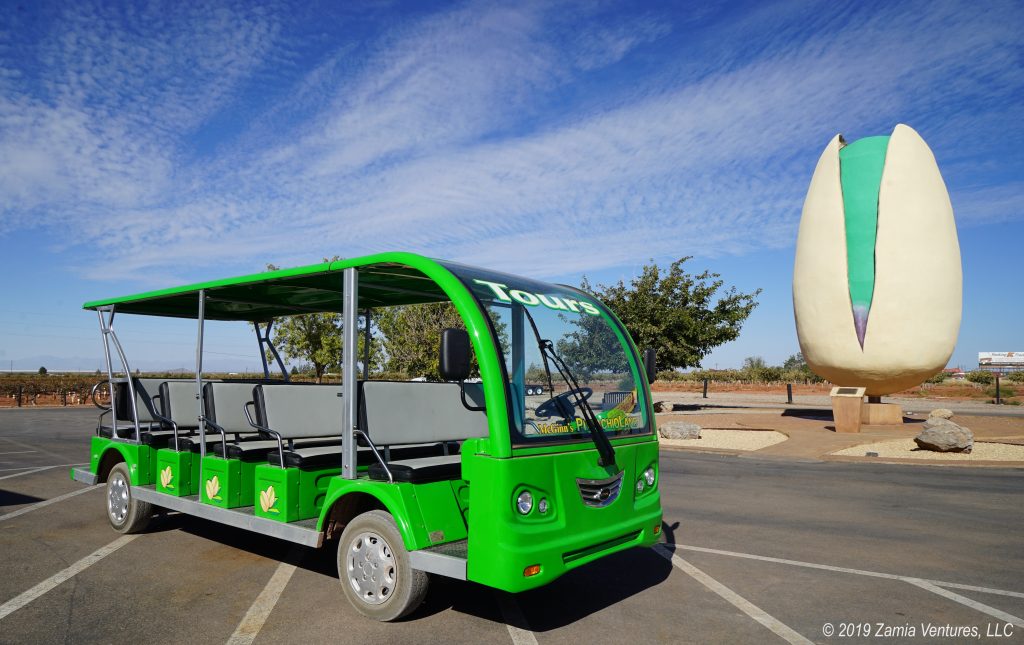
Pistachios are native to the Middle East but seem ideally suited for cultivation in New Mexico because they need long hot summers for proper seed ripening and cold winters for a dormant period. Another thing that helps is that pistachios are dioecious — there are separate male and female trees — and pollen from male trees is spread through the orchard by wind alone. This means the plants can thrive in New Mexico without any pollinator species, and this area is apparently quite windy in the spring blooming season.
One thing that is an issue for growing the tasty kind of pistachios (Pistacia vera) in the U.S. is soil-borne pathogens like verticillium wilt. As a result, virtually all P. vera grown in the U.S. is grafted into rootstocks from different Pistacia species. The rootstock cultivar used at Pistachioland is UCB #1, developed at UC Berkeley as a hybrid of P. atlantica (native to Iran) and P. integerrima (native to India), two other members of the cashew family. It was wild seeing the ridgy, oak-like bark along the bases of all the trees in the grove, with the smooth white bark of the P. vera above the obvious graft line. It was also a good reminder of just how much agriculture has changed the landscape of the earth as well as the very nature of the plants and animals we cultivate. Even when I am buying organic pistachios grown in the USA, they come from Franken-trees cobbled together from species originating on different continents.
The tram tour was about 20 minutes long, full of interesting information, and well-priced at $2/person, especially considering that the tour ticket is also good for a free cookie or $1 off an ice cream. What a deal! The general store adjacent to the giant pistachio sells tons of different pistachio products and New Mexico items, and also includes a wine tasting room. The pistachio tree farm property is home to a small vineyard that produces about six different types of wine. After experiencing the less-than-impressive wines of Arizona earlier this year, we skipped the wine tasting and went straight to the cookies, roasted pistachios, and hot pepper products. The vast sample bar convinced us to bring home several tasty treats.
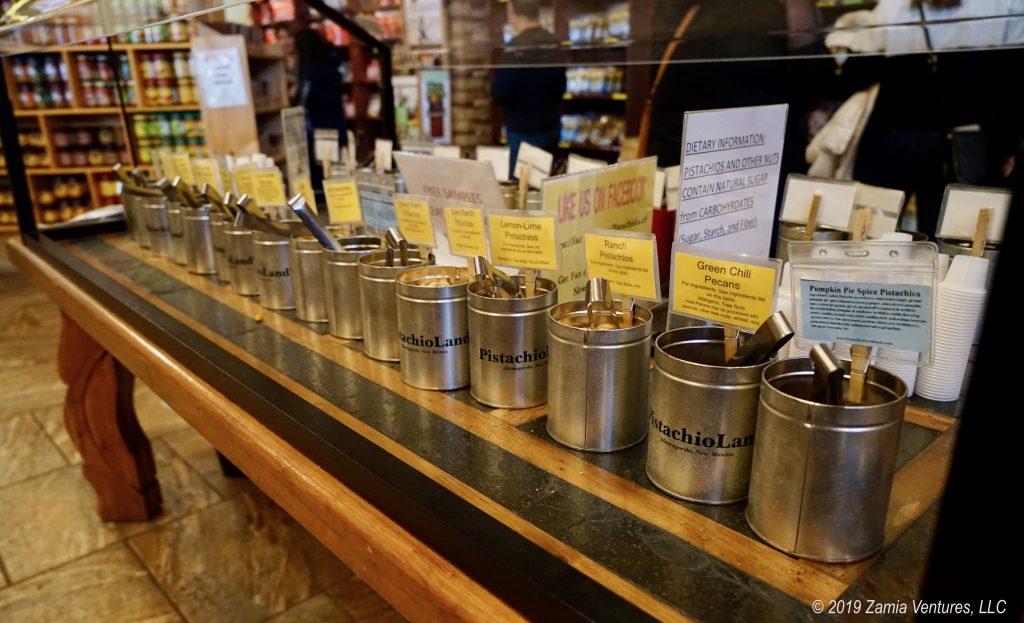
White Sands National Monument
Last but not least, we made sure to visit the White Sands National Monument west of Alamogordo to take in its unique environment. We don’t normally get excited about sand-based natural wonders. We were not all that impressed in our visit to the Bruneau Dunes in Idaho. We drove right by the Oregon Dunes last fall without stopping. We skipped Great Sand Dunes National Park in Colorado despite spending this entire summer criss-crossing the state. So it is high praise indeed when I say that White Sands was sort of interesting. It’s described as a “desert wetland,” a head-scratching oxymoron nicely reflecting the seasonal conditions that create the dunes.
The blinding white dunes are made of gypsum, the fine white material that’s used in drywall and plaster. At White Sands, the water-soluble gypsum erodes from surrounding mountains during the monsoon season, then recrystallizes in the playas on the floor of the Tularosa valley as water evaporates. The prevailing winds break up the soft crystals and pile the resulting fine sand in ever-shifting dunes that now cover around 275 square miles — the largest gypsum dunefield in the world. One sign of the constantly-changing landscape is the poor yuccas that grow extra-long stems to reach the light and air at the top of the dunes, only to collapse when the dunes shift away leaving the yucca’s head high and dry.
My favorite aspect of the park is the “bleached” creatures. The animals that live in the park are basically the same ones that exist in the surrounding desert: lizards, grasshoppers, mice, birds, and the like. But inside White Sands the ground-based prey animals are significantly lighter in color than those in the surrounding desert, an evolutionary adaptation to help them blend into the white dunes. It’s basically a naturally-occurring version of the famous color change in England’s peppered moths that took place in connection with the Industrial Revolution. Naturally we spent our entire visit looking for pasty white lizards, and we spotted at least one (though it ran off before I could get a good photo).
A Note on Grocery Shopping in Rural Areas
One travel issue that concerned us before hitting the road was access to decent groceries. Our views were colored by the fact that we had been exclusively Whole Foods shoppers for years before hitting the road. As it turns out, we have run across plenty of locations of our beloved Whole Foods, but we’ve also been completely satisfied shopping at places like City Market in Colorado, Hy-Vee in the Midwest, and various members of the Safeway and Kroger corporate groups. They have all been pretty comparable to Publix in Florida. In some places the Super Walmart has been the best option, and it is also fine. In all cases, though, we adjust our expectations to the size of the town. Which is why were were so amused to see the following review on Yelp of the Albertson’s in Alamogordo (pop. 30,000):
“Your offering of organic produce is marginal. What you have is old and not discounted. No organic hummus. The clerk would not take my Safeway discount card, even though they are both owned by the same Corporation. (I purchased over $200 of groceries). Also, NO Organic Blood Orange Italian Soda????? I don’t live here, just passing through, but really?????” — Clueless Yelp reviewer
We shopped at Albertson’s, and it was very nice! In related news, we now have a new code name in the household for completely misplaced outrage, and it is “blood orange soda.”
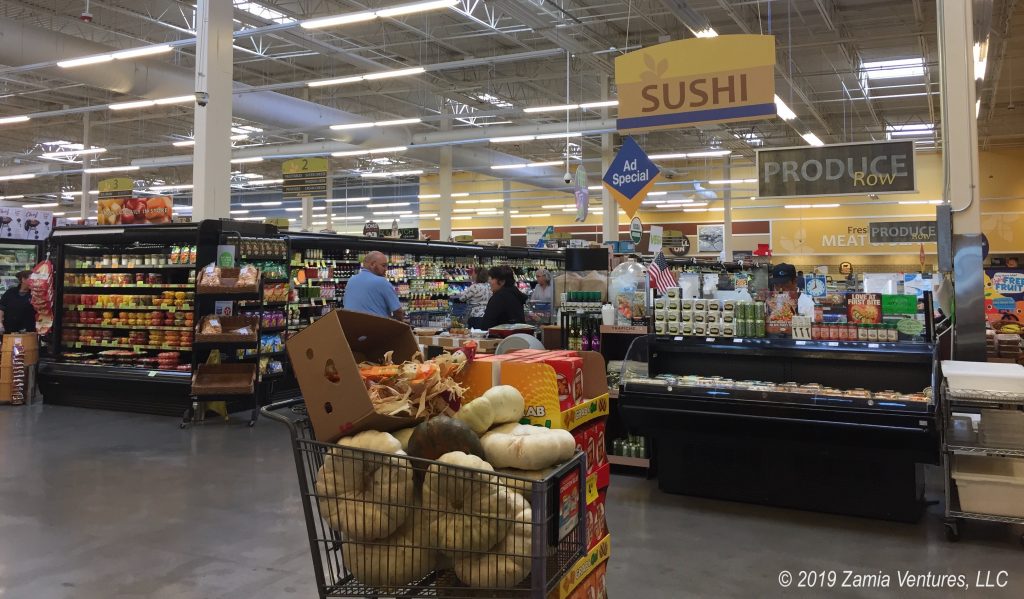
Next, we head southeasterly to check out two adjacent national parks: Guadalupe Mountains and Carlsbad Caverns.
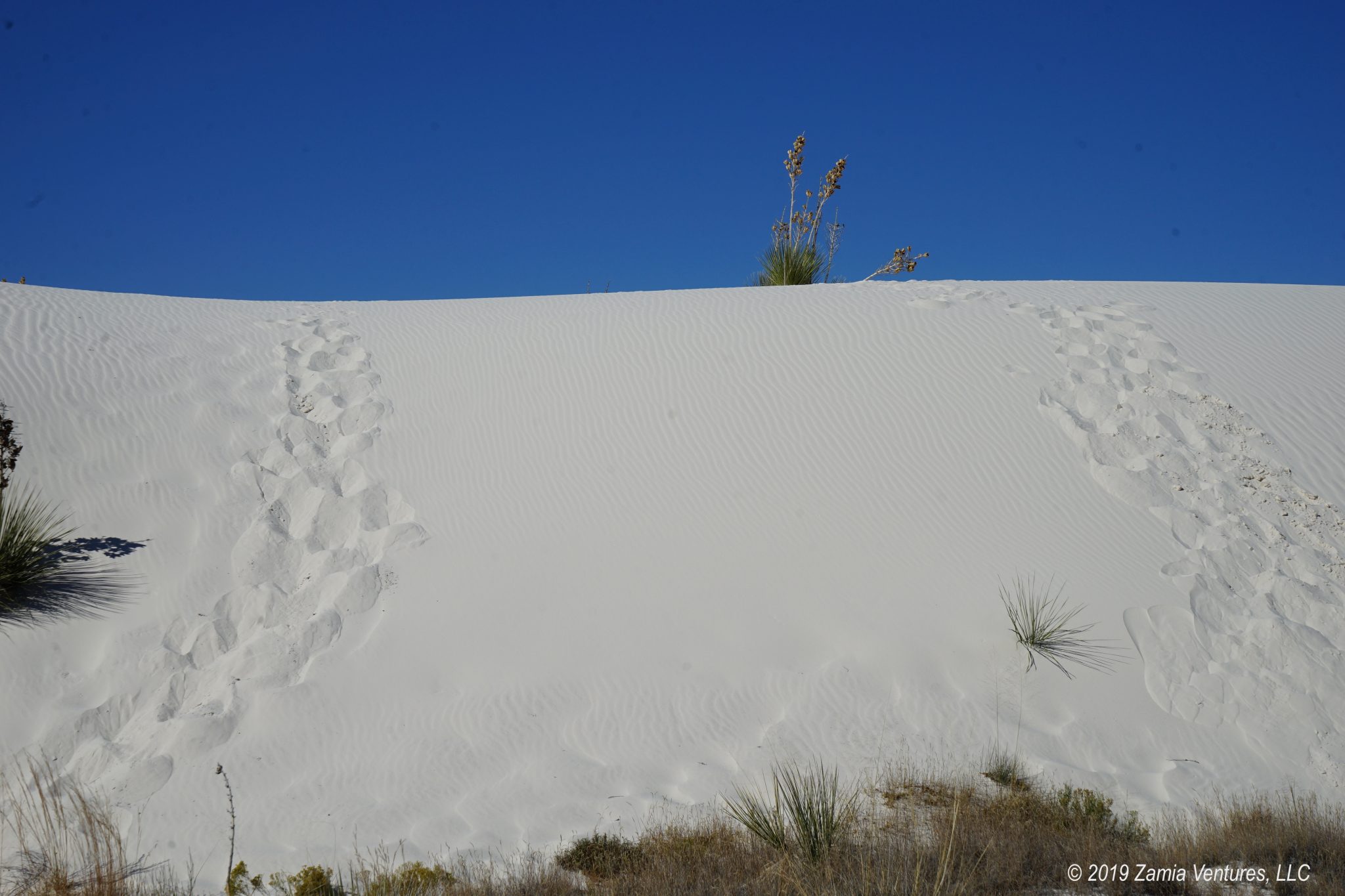
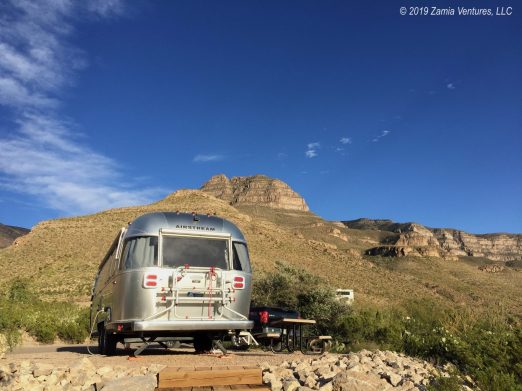
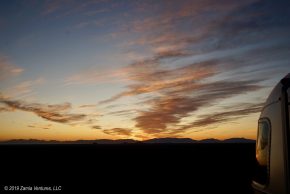
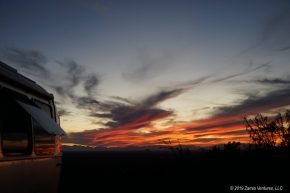
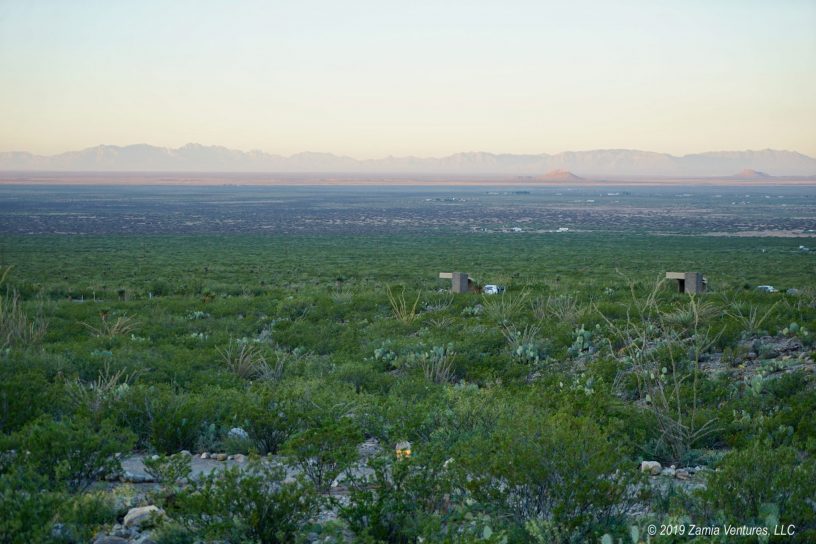
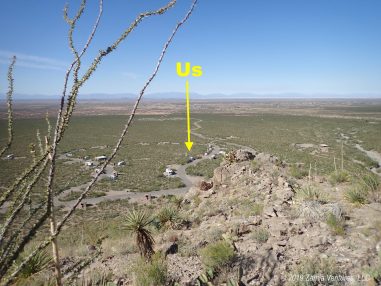
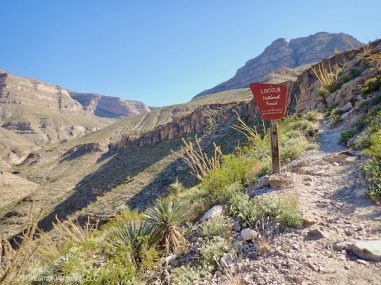
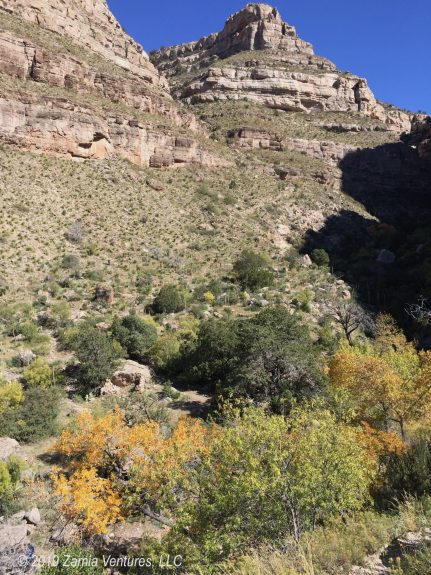
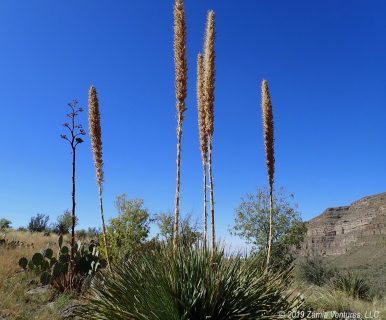
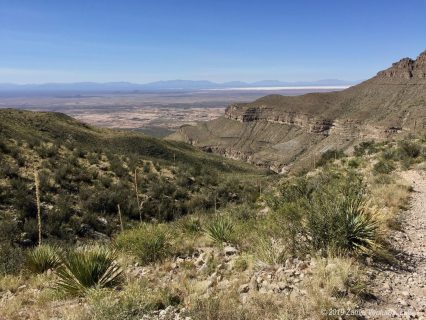
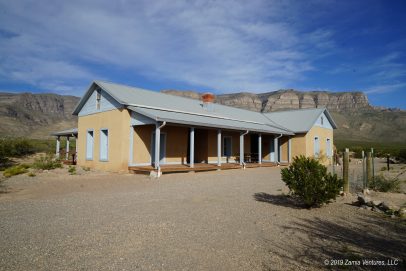
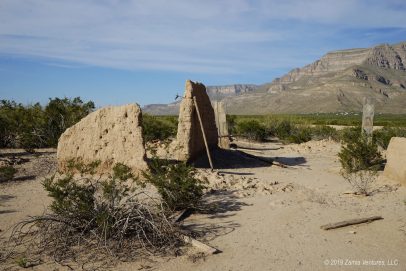
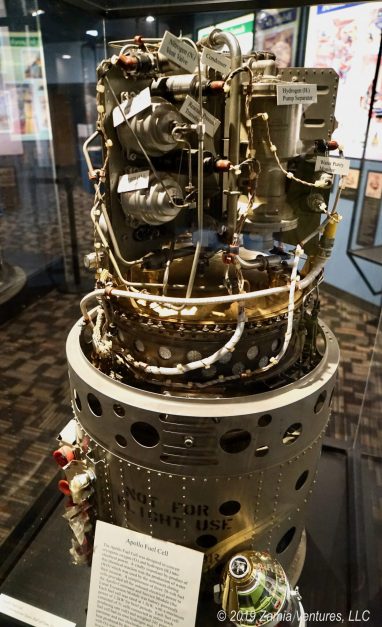
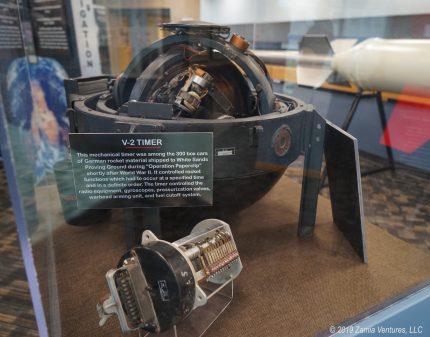
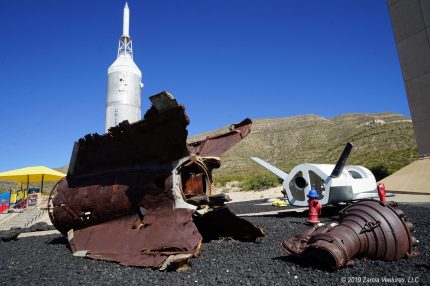
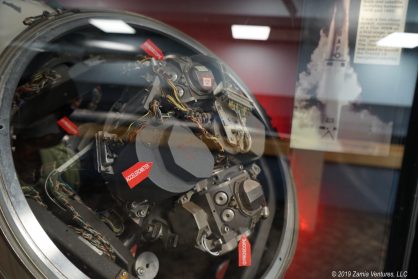
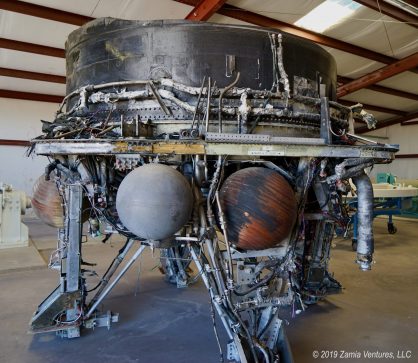
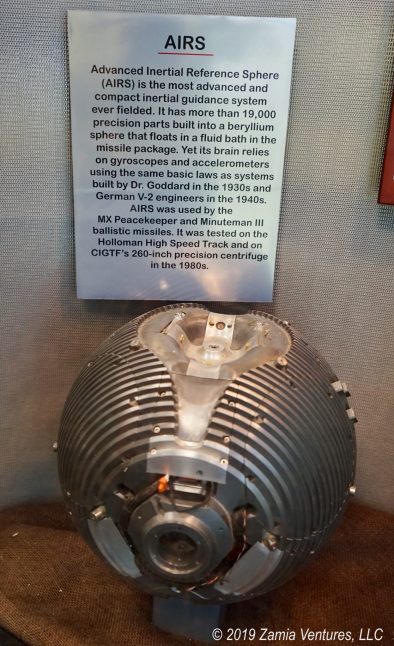
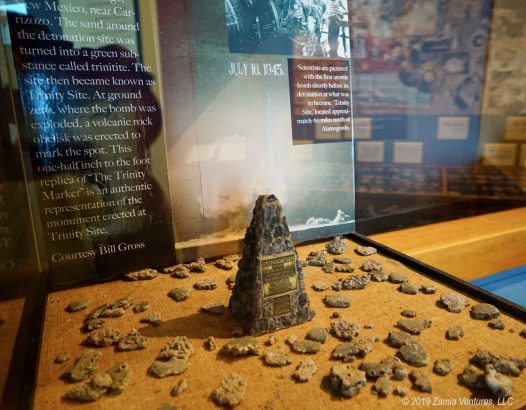
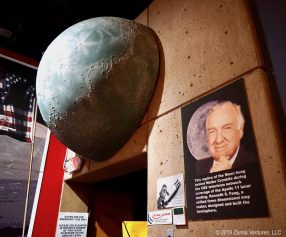
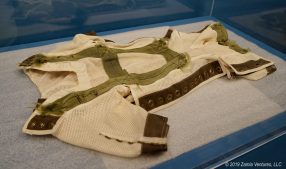
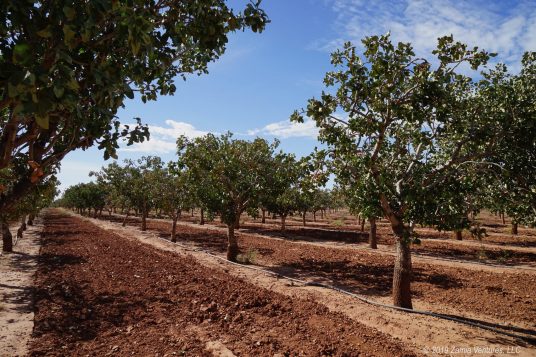
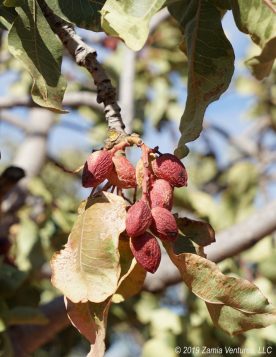
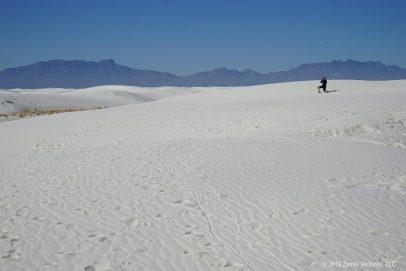
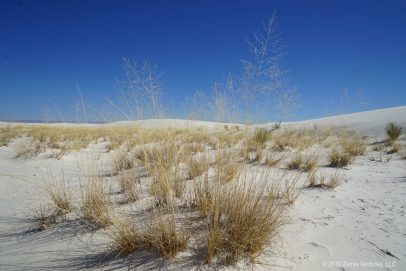
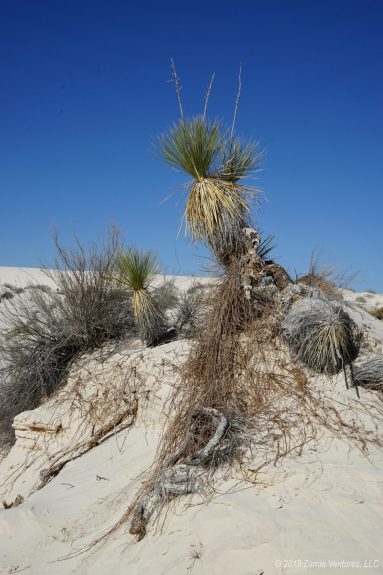
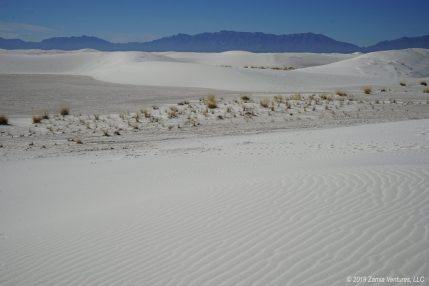
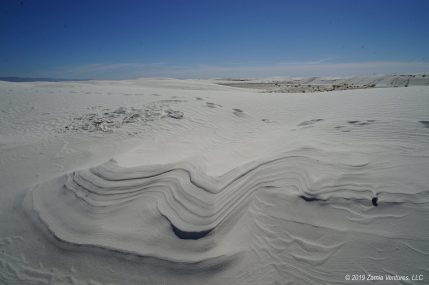
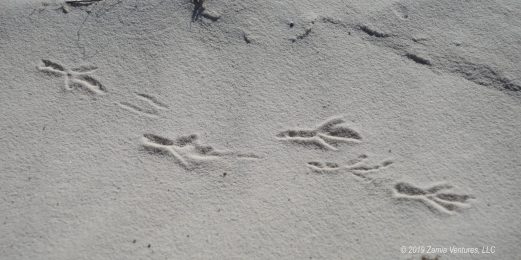
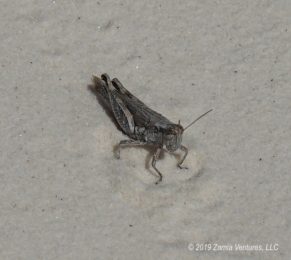
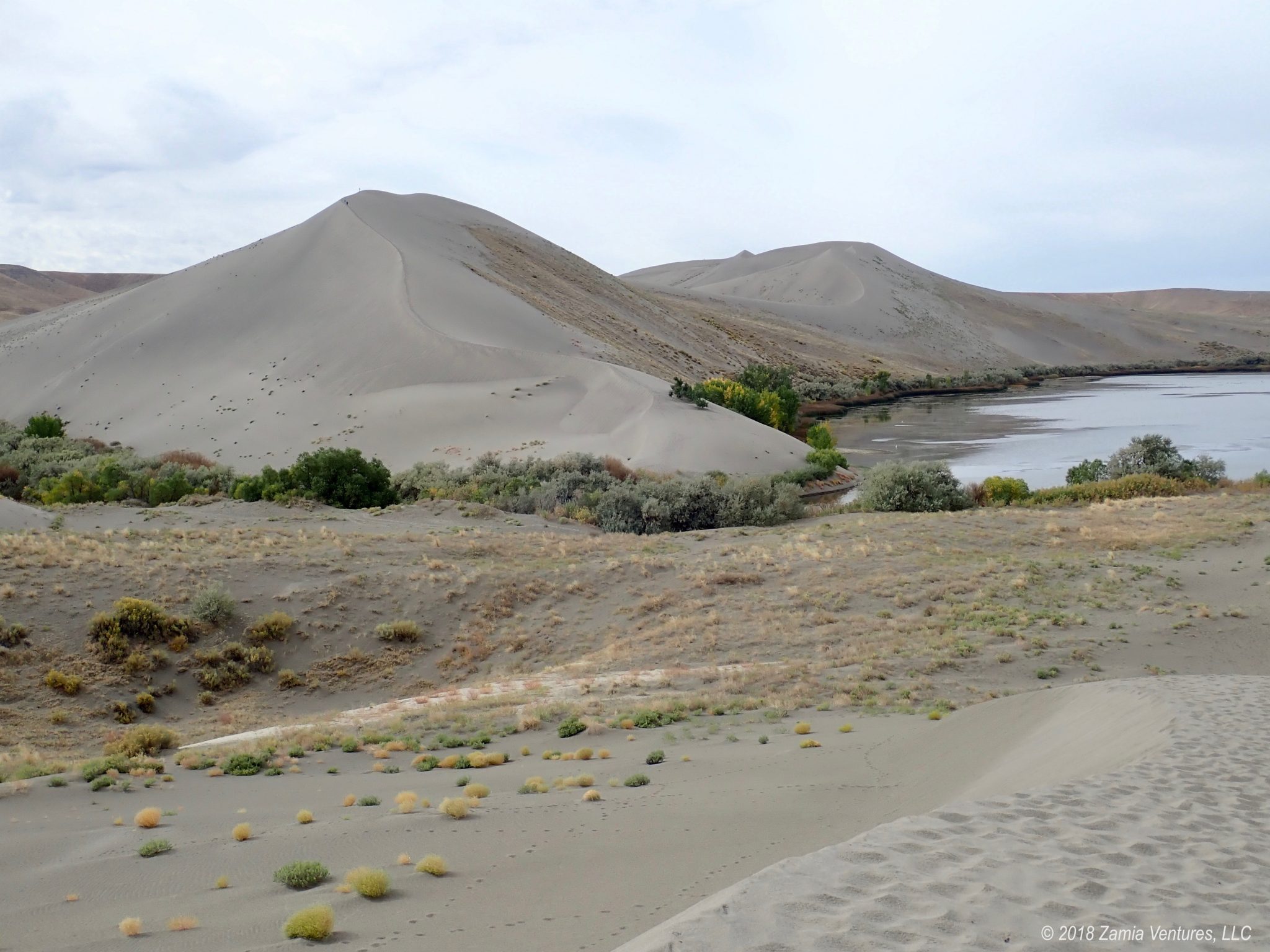
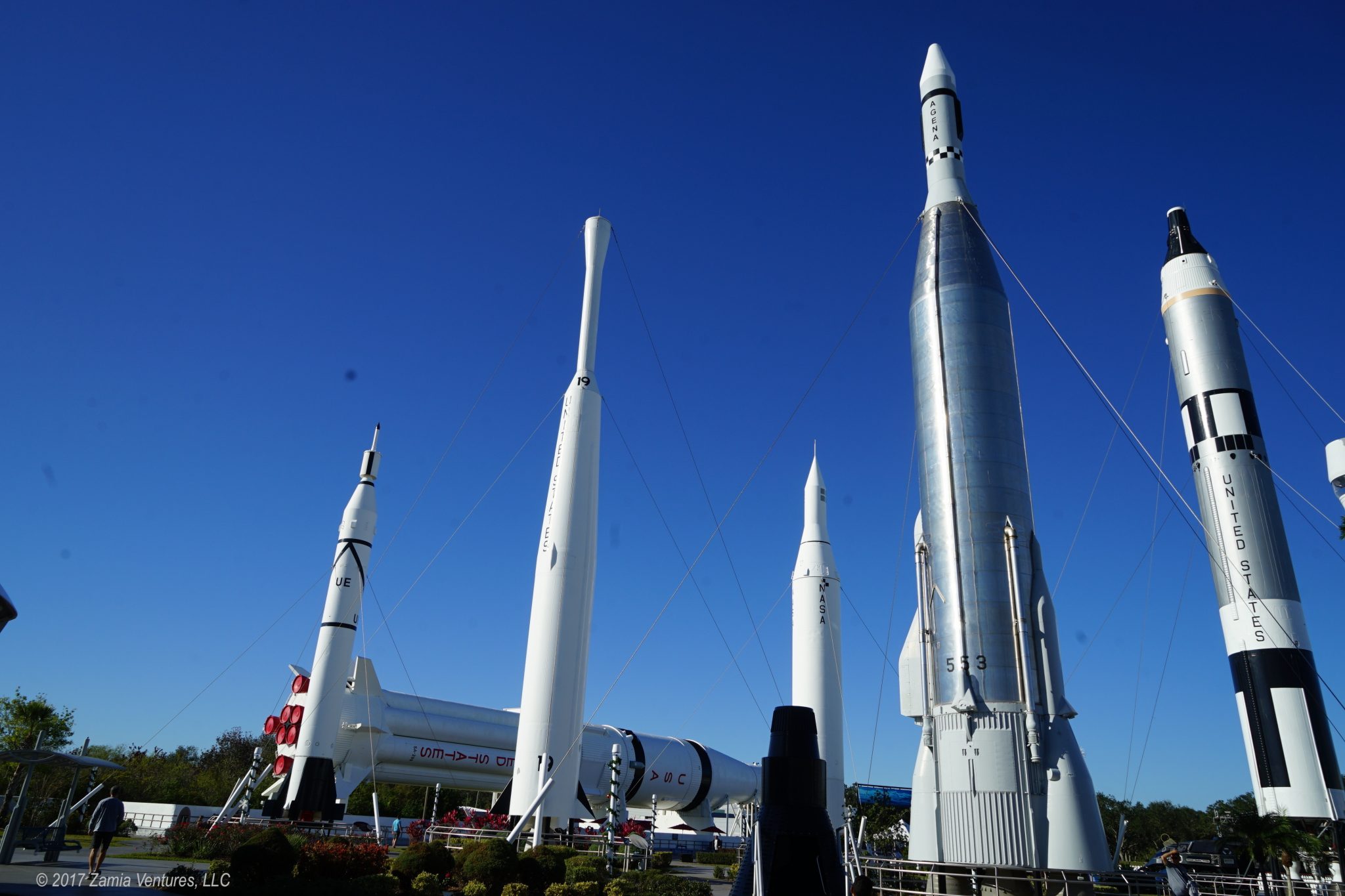
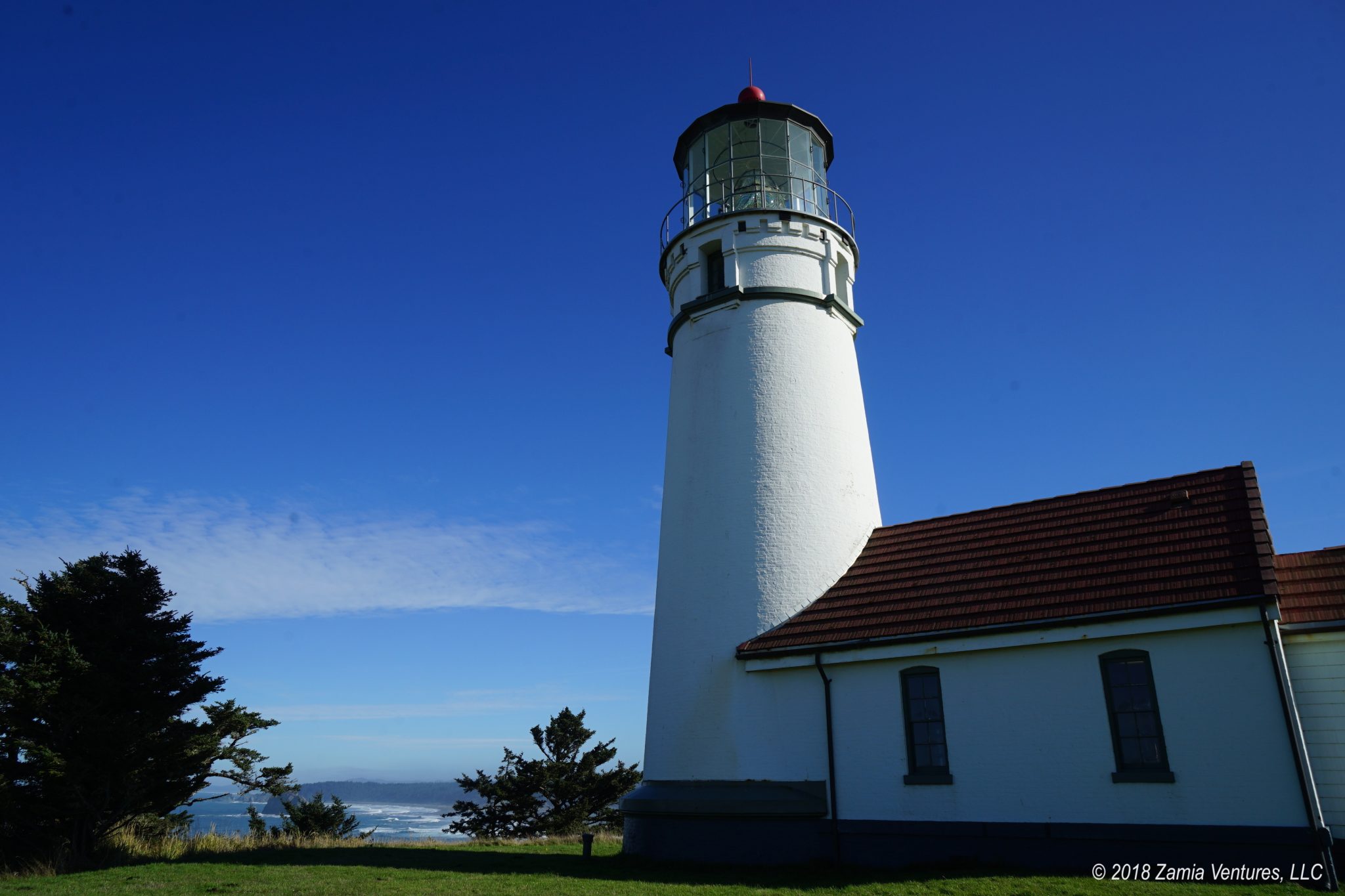
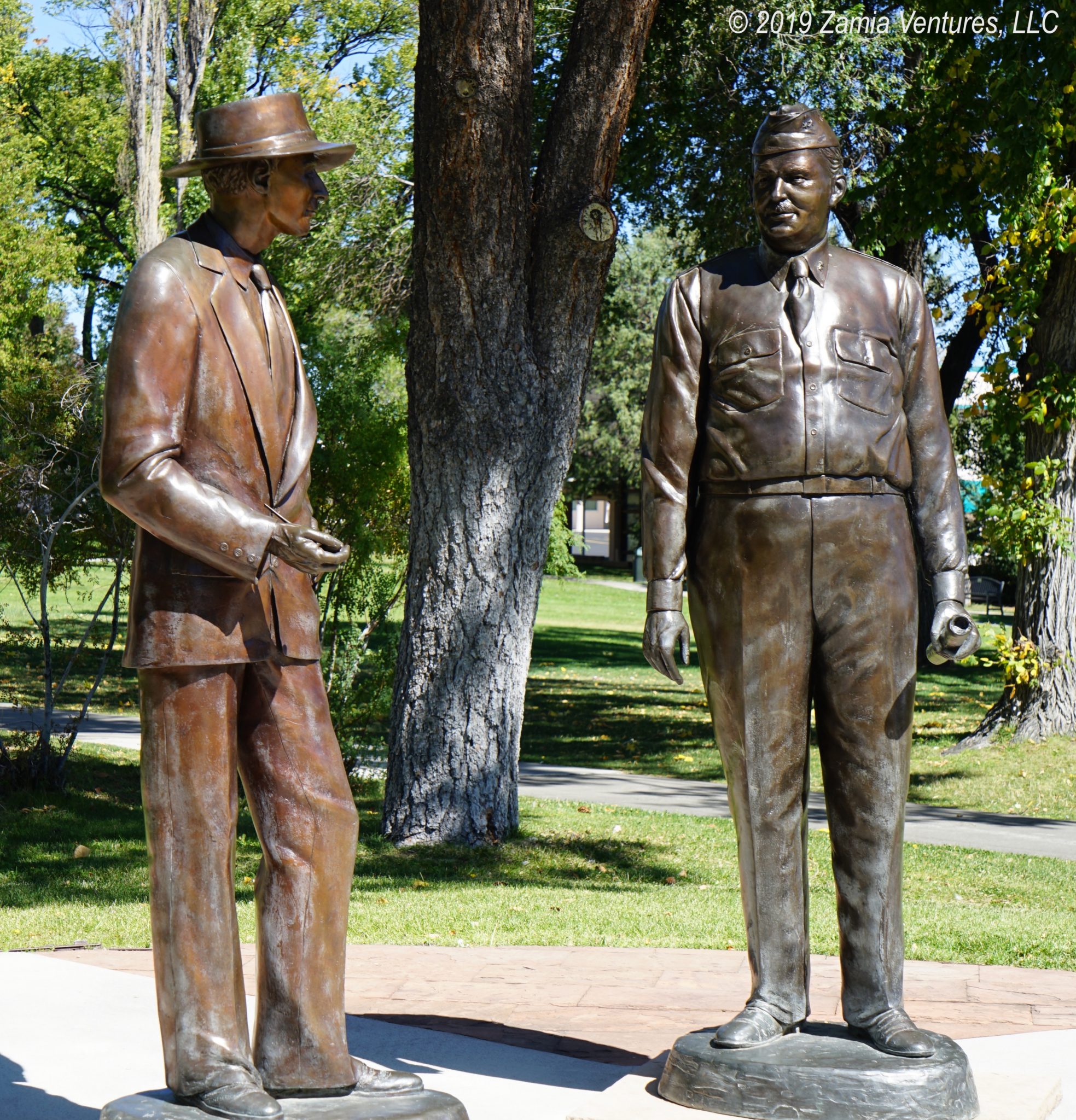
Hey, thanks for the shout-out! I’m glad you loved Oliver Lee as much as we did, and I only wish you could’ve been there during cacti bloom. I’m also glad you went to White Sands despite not being sand people LOL At least gypsum sand isn’t sticky!
We didn’t get to any of the pistachio places, but your post makes me wish we had. So yummy looking!
Chimps in space. I both love and hate that idea.
I love your new code-phrase! I’m headed to a WMSC in a little while, and when I’m near the beverages, I won’t be able to NOT look for blood-orange something!
We didn’t get to see any cacti in bloom, but we did get to see a very nice flush of leaves on all the ocotillo because of a big rainstorm a few weeks before our visit. It was pretty magical seeing the sun glowing through the leaves, though my photos didn’t capture it well.
I do recommend the Pistachioland tour. The retail store was totally kitschy — which didn’t stop us from getting sucked in and making purchases — but the farm tour was quite interesting!
Ken hated the chimps in space, and he has the support of the macho test pilot astronauts who were offended when a chimp was chosen to go to space before them. I thought it was sort of interesting from an animal training perspective but was left ambivalent about the animal testing side of things. Thought-provoking to be sure!
I mean, Kevin DOES love his blood orange soda, but I think even HE wouldn’t freak out TOO much if it wasn’t organic. LOL. People are nuts – and you really start realizing that fact when you begin reading online reviews- which we do a lot! If I see one more person on Yelp begin a review with “as someone from San Francisco/New York/whatever…. I know Thai food.” Oh, stop…. You know nothing. Shut it.
Anywhooooo, you definitely did this area right. I wish we had stayed at the State Park, I wish we had more time to check out the museum, and I wish we had been able to do the pistachio tour. They all look fantastic and I’m glad to hear they are worth a visit when we get back there.
What you apparently did not do, however, was go sledding! That was seriously fun!! (except slogging back up the hills… that sucked as much as it did when we were kids going snow sledding…)
Sounds like a perfect stop. Please keep me posted on where you find the blood orange soda. 🙂
Your post was so helpful in our planning, particularly when you discussed the things that you regretted missing. So your failure turned into our success… thank you! And you could definitely fit in the reservable spots at Oliver Lee. They are sort of weirdly shaped — basically round gravel areas — so there is flexibility to sit at an angle. Our site (#4) would have easily fit a large motorhome; we backed in diagonally and before unhitching just the front two or three feet of our 46 foot length was overhanging the road.
We did not go sledding, but we did watch others attempting it. Watching a mom repeatedly attempting, and failing, to video her kid sledding down a hill was priceless. At first the sled wouldn’t slide at all, then it went too fast before she was ready, etc. It was pretty entertaining, and we didn’t even need to slog up a sandy hill to enjoy it!
We stayed at Oliver Lee several years ago and loved it. That Dog Canyon Trail is a kick-ass hike (straight uphill, as you know) but beautiful. We’ve always wanted to return because we only had a couple of days there, it was too windy to visit White Sands, and the tour of the ranch wasn’t happening while we were there.
Thanks for the tip on visiting the pistachio farm! I find it fascinating that new and improved trees can be created with grafting, even if they do look a bit odd. Which now has got me thinking about grafting, and wondering if that’s a bad thing akin to GMOs. Anyway, I need to stop myself from going down that rabbit hole. I spend too much time on the computer as it is (looking at Yelp reviews, for example, LOL).
Agree about the trail, though we found the downhill part to be the most taxing because of the steep incline combined with loose rocks. Very tricky! The park itself was really a revelation, especially considering that the Alamogordo area is not all that inherently scenic.
I personally don’t have a problem with grafting — I love things like nuts and wine too much to complain — but it’s a good reminder to myself that in the world of modern agriculture there is basically no such thing as eating what our ancestors ate. (As a side note, I really don’t understand how the Paleo diet can make that claim.) I’ve actually worked on updating a few old family recipes because the modern ingredients (like nuts and eggs) are so much larger and richer (fattier) than in the old country. Even our flour has much more protein, which is a great thing for human nutrition, but changes how the ingredients interact. In any case, we really enjoyed seeing agriculture up close and recommend the very affordable tour at Pistachioland.